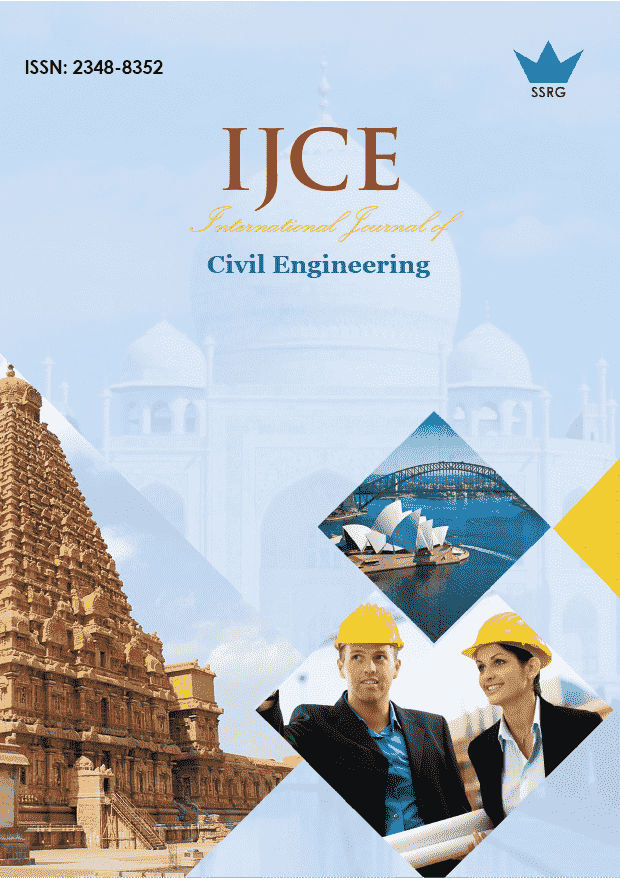Noise Emission Curves for Train in Arrival, In-front and Departure Mode

| International Journal of Civil Engineering |
| © 2025 by SSRG - IJCE Journal |
| Volume 12 Issue 4 |
| Year of Publication : 2025 |
| Authors : Brind Kumar, Amarjeet Kumar Himanshu, Ashish Kumar Chouksey, Amar Deep Pandey |
How to Cite?
Brind Kumar, Amarjeet Kumar Himanshu, Ashish Kumar Chouksey, Amar Deep Pandey, "Noise Emission Curves for Train in Arrival, In-front and Departure Mode," SSRG International Journal of Civil Engineering, vol. 12, no. 4, pp. 128-133, 2025. Crossref, https://doi.org/10.14445/23488352/IJCE-V12I4P113
Abstract:
Rail transport has long been a cornerstone of societal development, contributing significantly to economic growth by facilitating the movement of goods and people. However, it also presents environmental challenges, one of the most prominent being noise pollution, affecting both urban and rural populations. This paper addresses the critical issue of railway noise emissions by identifying and analyzing the various noise sources produced during train operations. Noise emission curves were developed for trains in three distinct operational modes - arrival, in-front and departure. Analysis was done on a dataset of 180 noise measurements for trains traveling at different speeds using a Class 1 sound level meter, kept at the height of 1.2m from the ground, to simulate the location of human ears at a safe distance from the center of the track. The overall LAeq of trains passing a point, encompassing the arrival, in-front, and departure phases, ranged from 53.3 to 104.0 dB(A), with a mean value of 87.05 dB(A). Detailed analysis indicated that a logarithmic curve best fits the noise data across all modes and vehicle categories, supported by an R² value of about 0.85 during both the training and testing stages. This suggests the logarithmic model effectively represents the measured noise levels of concurrently moving noise sources loosely bound together. R² values indicate that the developed equations are reliable for predicting train noise emissions under various conditions. Notably, the mean actual and root mean square error for the arrival stage were both under 1 dB(A), which is lower than that for other stages. These predictive models can be helpful in noise mitigation efforts, offering a tool for railway planners and engineers to forecast noise levels and implement appropriate control measures.
Keywords:
Rail noise, Environment, Rolling noise, Cruising noise.
References:
[1] Prabal Bandyopadhyay, Sunil Kumar Bhattacharya, and Shri Kant Kashyap, “Assessment of Noise Environment in a Major Railway Station in India,” Industrial Health, vol. 32, no. 3, pp. 187-192, 1994.
[CrossRef] [Google Scholar] [Publisher Link]
[2] Indrayani et al., “Analysis of Train Noise Level at Bandar Khalipah Station, Deli Serdang Using Sound Level Meter 130 dB,” Journal of Physics: Conference Series, The 2nd International Conference on Sciences and Technology Applications, Medan City, Indonesia, vol. 1811, no. 1, pp. 1-11, 2021.
[CrossRef] [Google Scholar] [Publisher Link]
[3] Oludare Isaac Abiodun et al., “State-of-the-Art in Artificial Neural Network Applications: A Survey,” Heliyon, vol. 4, no. 11, pp. 1-41, 2018.
[CrossRef] [Google Scholar] [Publisher Link]
[4] Saade Abdalkareem Jasim et al., “Noise Pollution in Rail Transport. Case Study: Baghdad Subway,” Noise Mapping, vol. 9, no. 1, pp. 113-119, 2022.
[CrossRef] [Google Scholar] [Publisher Link]
[5] Boddu Sudhir Kumar, and Venkaiah Chowdary, “Use of Artificial Neural Networks to Assess Train Horn Noise at a Railway Level Crossing in India,” Environmental Monitoring and Assessment, vol. 195, 2023.
[CrossRef] [Google Scholar] [Publisher Link]
[6] Kranti Kumar et al., “Diurnal Rail Noise Measurement, Analysis, and Evaluation of Associated Health Impacts on Residents Living in the Proximity of Rail Track Area,” Environmental Monitoring and Assessment, vol. 196, 2024.
[CrossRef] [Google Scholar] [Publisher Link]
[7] Changwoo Lim et al., “The Relationship between Railway Noise and Community Annoyance in Korea,” The Journal of the Acoustical Society of America, vol. 120, no. 4, pp. 2037-2042, 2006.
[CrossRef] [Google Scholar] [Publisher Link]
[8] Dongyun Liu et al., “A Review on Aerodynamic Load and Dynamic Behavior of Railway Noise Barriers when High-Speed Trains Pass,” Journal of Wind Engineering and Industrial Aerodynamics, vol. 239, pp. 1-21, 2023.
[CrossRef] [Google Scholar] [Publisher Link]
[9] Maria Michali et al., “Noise-Pollution Efficiency Analysis of European Railways: A Network DEA Model,” Transportation Research Part D: Transport and Environment, vol. 98, 2021.
[CrossRef] [Google Scholar] [Publisher Link]
[10] Sibylle Pennig, and Arthur Schady, “Railway Noise Annoyance: Exposure-Response Relationships and Testing a Theoretical Model by Structural Equation Analysis,” Noise and Health, vol. 16, no. 73, pp. 388-399, 2014.
[CrossRef] [Google Scholar] [Publisher Link]
[11] Małgorzata Szwarc et al., “Problems of Railway Noise—A Case Study,” International Journal of Occupational Safety and Ergonomics, vol. 17, no. 3, pp. 309-325, 2011.
[CrossRef] [Google Scholar] [Publisher Link]
[12] Sarah Weidenfeld et al., “Effects of Railway Rolling Noise on Perceived Pleasantness,” Transportation Research Part D: Transport and Environment, vol. 126, 2024.
[CrossRef] [Google Scholar] [Publisher Link]
[13] Giacomo Gustavo Wosniacki, and Paulo Henrique Trombetta Zannin, “Framework to Manage Railway Noise Exposure in Brazil Based on Field Measurements and Strategic Noise Mapping at the Local Level,” Science of the Total Environment, vol. 757, 2021.
[CrossRef] [Google Scholar] [Publisher Link]
[14] Syed Yakub Ali, and Shibani Chaudhury, “Study of the Railway Noise Level in Bolpur and Prantik Station, India,” Research Journal of Recent Sciences, vol. 5, no. 4, pp. 23-28, 2016.
[Google Scholar] [Publisher Link]

 10.14445/23488352/IJCE-V12I4P113
10.14445/23488352/IJCE-V12I4P113